Chronicle 1: The Shunned Cellar

Introduction
Beneath the crumbling facades of Arkham's forgotten manors lies more than just rot and dust. When a bricked-over cellar is discovered beneath the Mallory estate—absent from records and steeped in foul heat—paranormal investigator Nathaniel Crowe is summoned into a mystery older than the soil itself.
What begins as a search for truth spirals into a descent through distorted time, ancestral dread, and cryptic architecture designed to contain something… not quite dead. As symbols bloom in stone, memories rewrite themselves, and reality begins to buckle, Crowe must confront an ancient intelligence whose prison is failing—and whose whispers have begun to call his name.
From the shadowed alleys of Arkham to the mist-choked cliffs of Kingsport, The Shunned Cellar is a chilling tale of containment, legacy, and the inescapable hunger of forgotten gods.
Author's Note
This series of chronicles began as an experiment—an exploration into the creative potential of artificial intelligence as a tool for storytelling. What started as a test soon evolved into a fully structured literary project: a serialized expansion rooted in the public domain works of H.P. Lovecraft.
The seed was planted years earlier, when I first stumbled into the strange, fog-draped corridors of the Cthulhu Mythos. There was something irresistible about its vastness—its silence between known names and hinted corners. The mythos is so loosely threaded that with enough tenacity and imagination, almost anything can be conjured into existence. I was drawn not just to its monstrous pantheon, but to its philosophical weight—the idea that meaning is fragile, and survival often hinges more on mental endurance than physical strength. To endure the unknown, one must sharpen the mind and steel the soul.
Through this collaboration between human imagination and machine-assisted generation, a new body of lore has emerged. New characters, locations, entities, and artifacts now walk alongside the familiar shadows of Lovecraft’s mythos, weaving original narrative arcs that deepen with each installment.
The creative process behind this chronicle employs artificial intelligence as a tool—always guided, shaped, and refined by human intent. The first two chronicles are deliberately brief, primer-length installments meant to set voice and atmosphere. As our development process matures, subsequent releases expand in scope and length, growing into more comprehensive investigations.
Not of any official canon, but of the strange, unsettling impulse that first gave rise to cosmic horror itself—these chronicles are a continuation. They are my offering to that darkness, a record of what happens when curiosity exceeds caution, and the veil is drawn back just a little too far.
Yours in ink and inquiry,
—Custodian of the Hidden Ledger
Retrieve Your Copy from the Stacks
Here's where this chronicle rests in quiet order, awaiting the hand that would turn its pages.
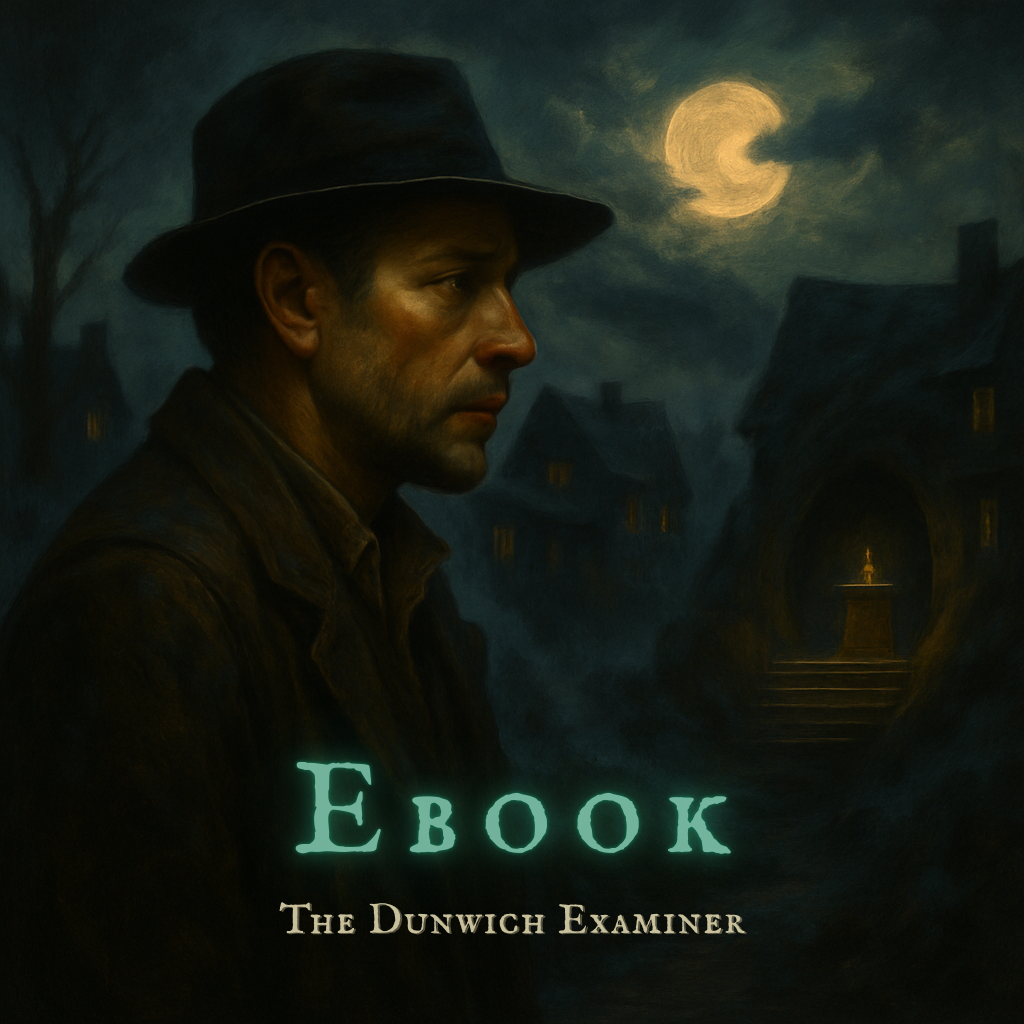
Coming Soon
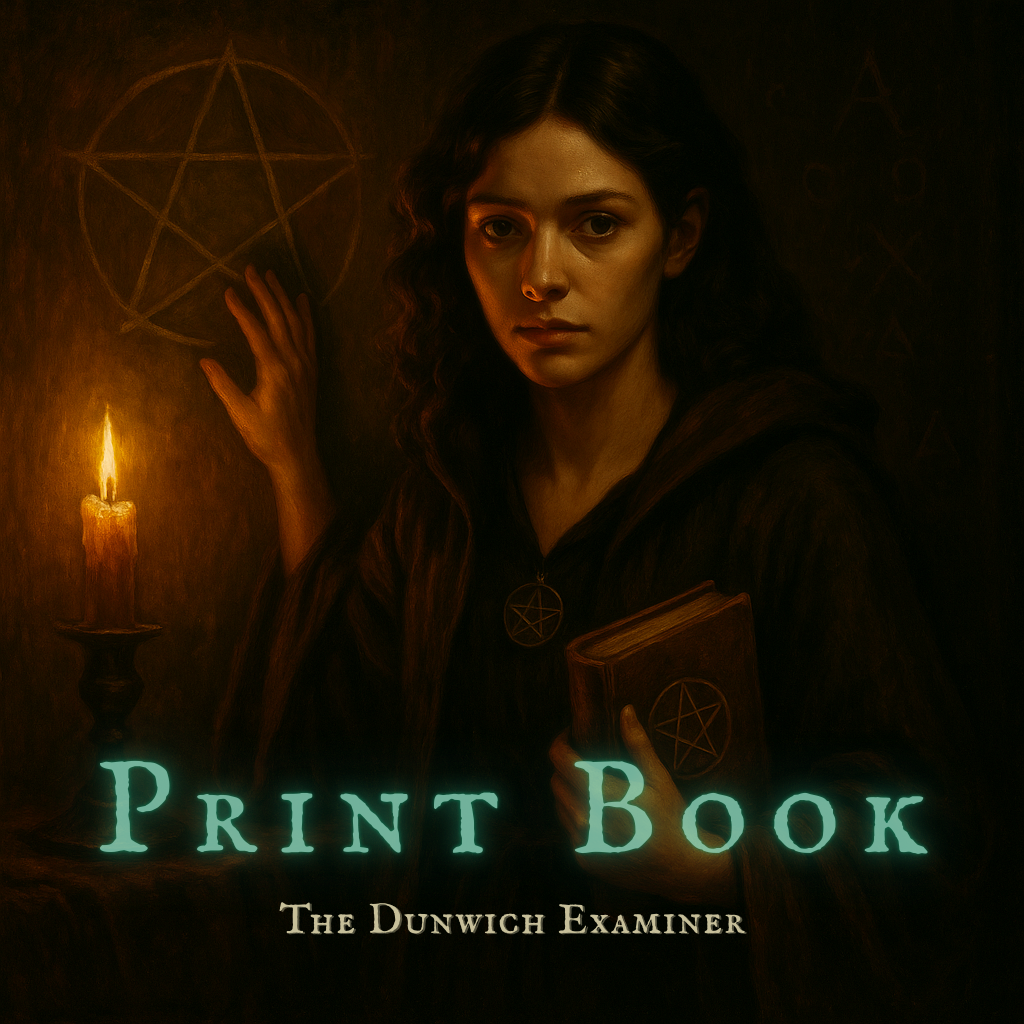
Coming Soon
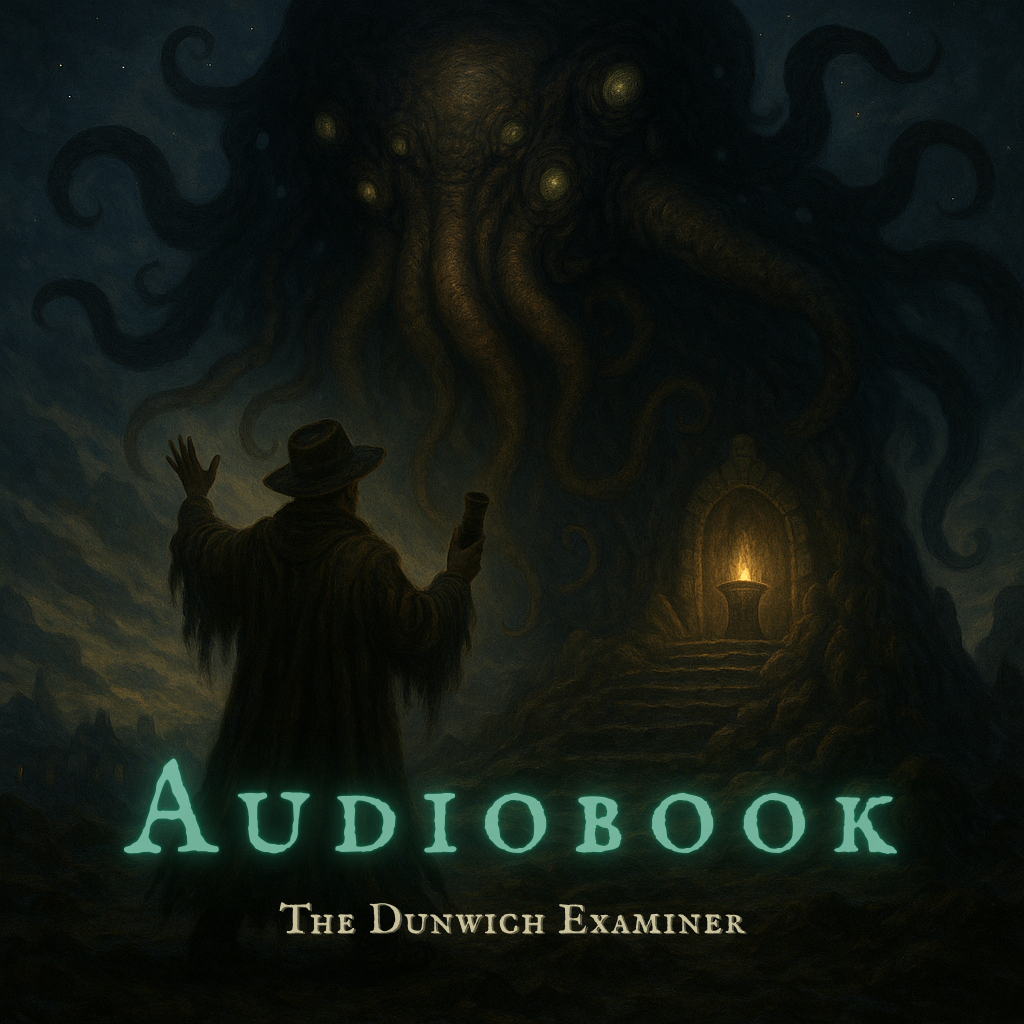
Coming Soon
You may leave your account of the chronicle on any of the platforms listed above.

Scattered across the years are objects pulled from crumbling ruins, forsaken burial grounds, and vaults sealed for reasons now half-forgotten. These relics, some no larger than a coin and others too heavy to be moved, have been gathered here for study and documentation. Each bears the weight of an untold history, and in many cases, an influence that lingers long after it leaves its resting place.
Some artifacts are tools of mundane origin, later altered—or corrupted—by forces beyond comprehension. Others were crafted with intent from the very beginning, their materials and design steeped in symbols older than recorded language. Many resist proper classification, their function guessed at only through fragmented notes, obscure references, and the testimony of those who came too close.
To examine them is to risk more than idle curiosity, for certain objects exert a pull upon the mind, a subtle insistence to be handled, studied, or claimed. Yet in understanding them, however imperfectly, we gain insight into the hidden currents shaping our world—and perhaps the means to resist what lies ahead.
Case File Appendices
Field Report: Mallory Estate Subcellar Excavation
A firsthand account from Arthur Pendell detailing the unsettling discoveries beneath the Mallory estate.
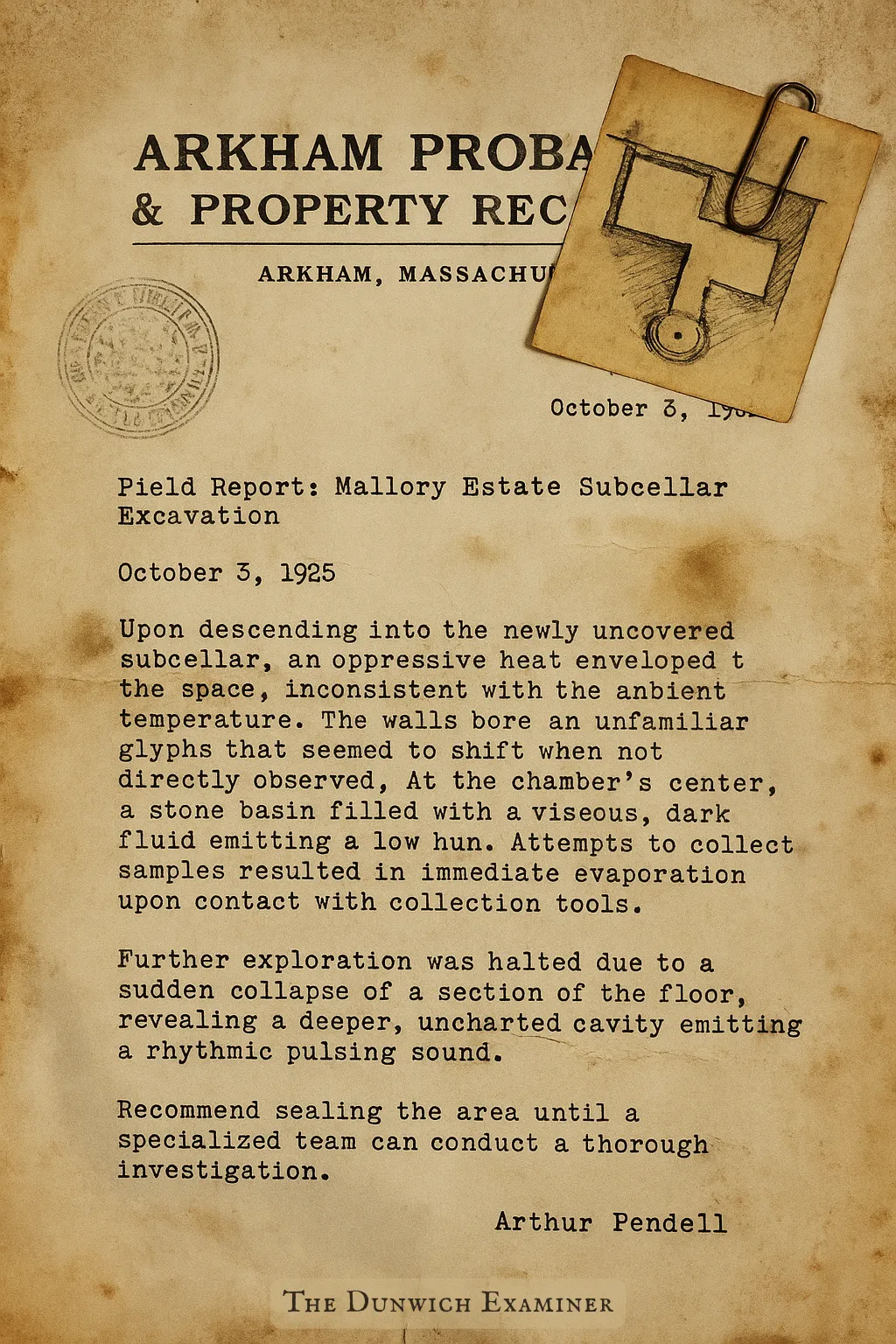
Investigator: Arthur Pendell
Upon descending into the newly uncovered subcellar, an oppressive heat enveloped the space, inconsistent with the ambient temperature. The walls bore unfamiliar glyphs that seemed to shift when not directly observed. At the chamber's center stood a stone basin filled with a viscous, dark fluid emitting a low hum. Attempts to collect samples resulted in immediate evaporation upon contact with collection tools.
Further exploration was halted due to the sudden collapse of a section of the floor, revealing a deeper, uncharted cavity emitting a rhythmic pulsing sound.
Recommend sealing the area until a specialized team can conduct a thorough investigation.
Ledger Page: Testimony of the Lost Workman
A recovered page said to belong to a laborer contracted for repairs beneath the Mallory estate. The entry ends abruptly, as if interrupted by the cellar itself.
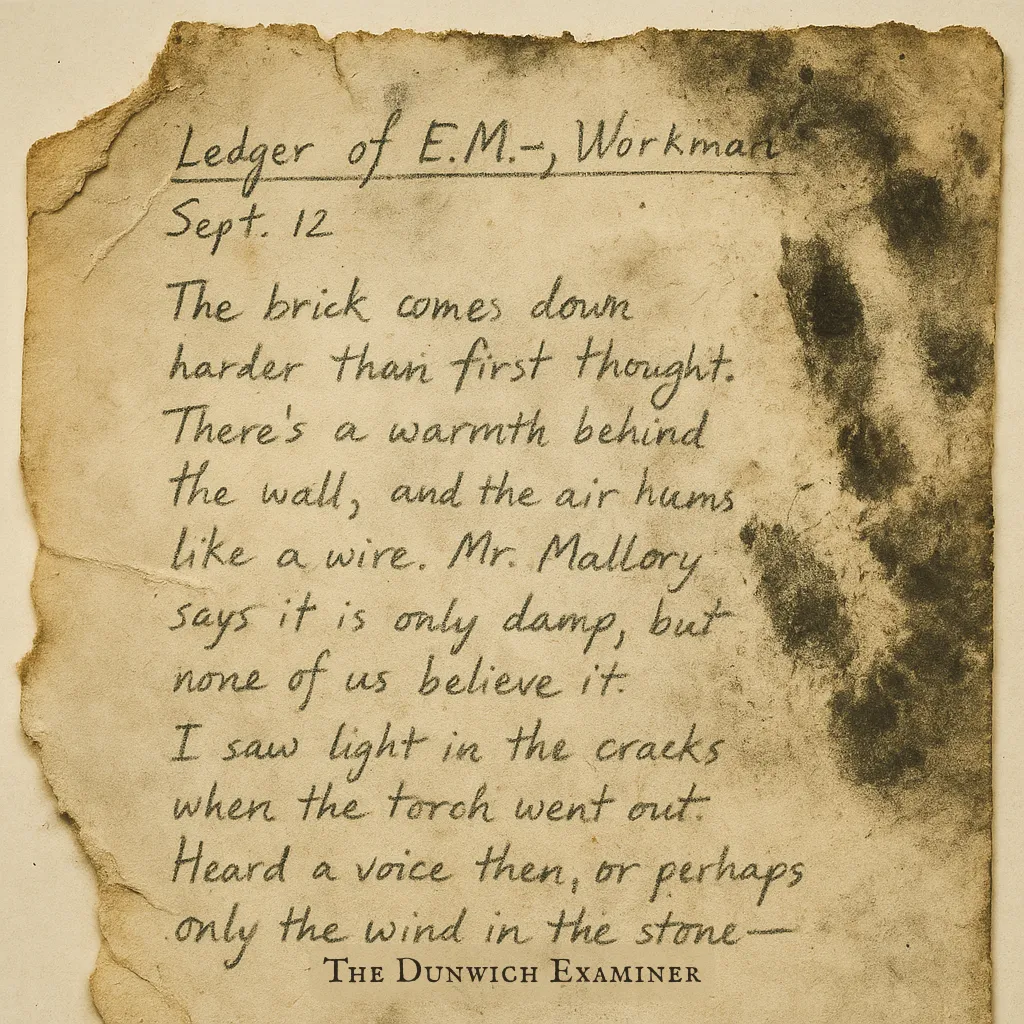
Ledger of E. M—, Workman
The brick comes down harder than first thought. There’s a warmth behind the wall, and the air hums like a wire. Mr. Mallory says it is only damp, but none of us believe it. I saw light in the cracks when the torch went out.
Heard a voice then, or perhaps only the wind in the stone—
[Entry terminates abruptly]
Suppressed Materials
Letter: From the Desk of Dr. Elias Harrow
A confidential letter from Dr. Harrow expressing concerns over the Mallory estate's influence on local residents.
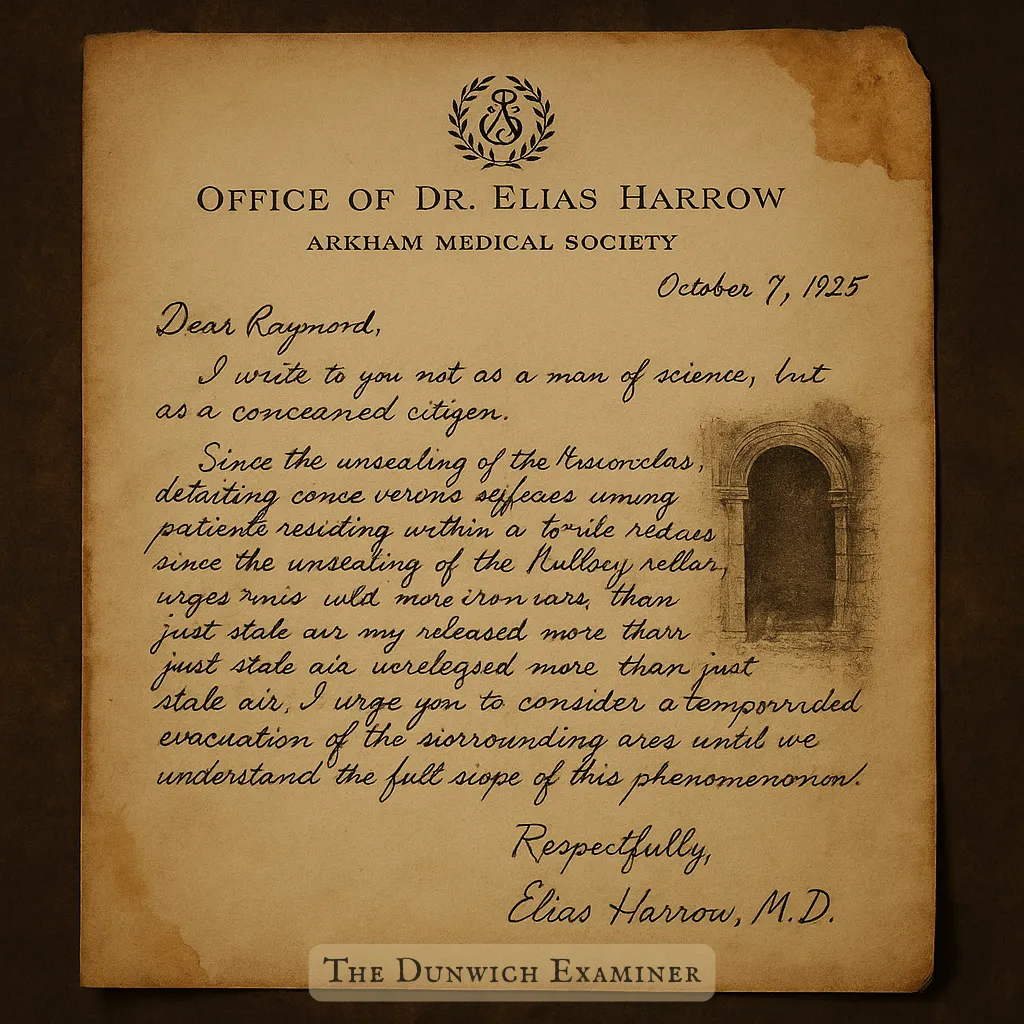
Recipient: Chief Constable Raymond
Dear Raymond,
I write to you not as a man of science, but as a concerned citizen. Since the unsealing of the Mallory cellar, I've observed a marked increase in sleep disturbances among patients residing within a two-mile radius. Reports of night terrors, somnambulism, and, in one case, temporary aphasia have surfaced. I fear the cellar's opening has released more than just stale air. I urge you to consider a temporary evacuation of the surrounding area until we understand the full scope of this phenomenon.
Respectfully,
Dr. Elias Harrow
Ledger Extract: Blackwood Cemetery Records
A copied page from Jeremiah Toll’s cemetery register, noting burials and anomalies in the weeks following the Mallory estate’s unsealing.
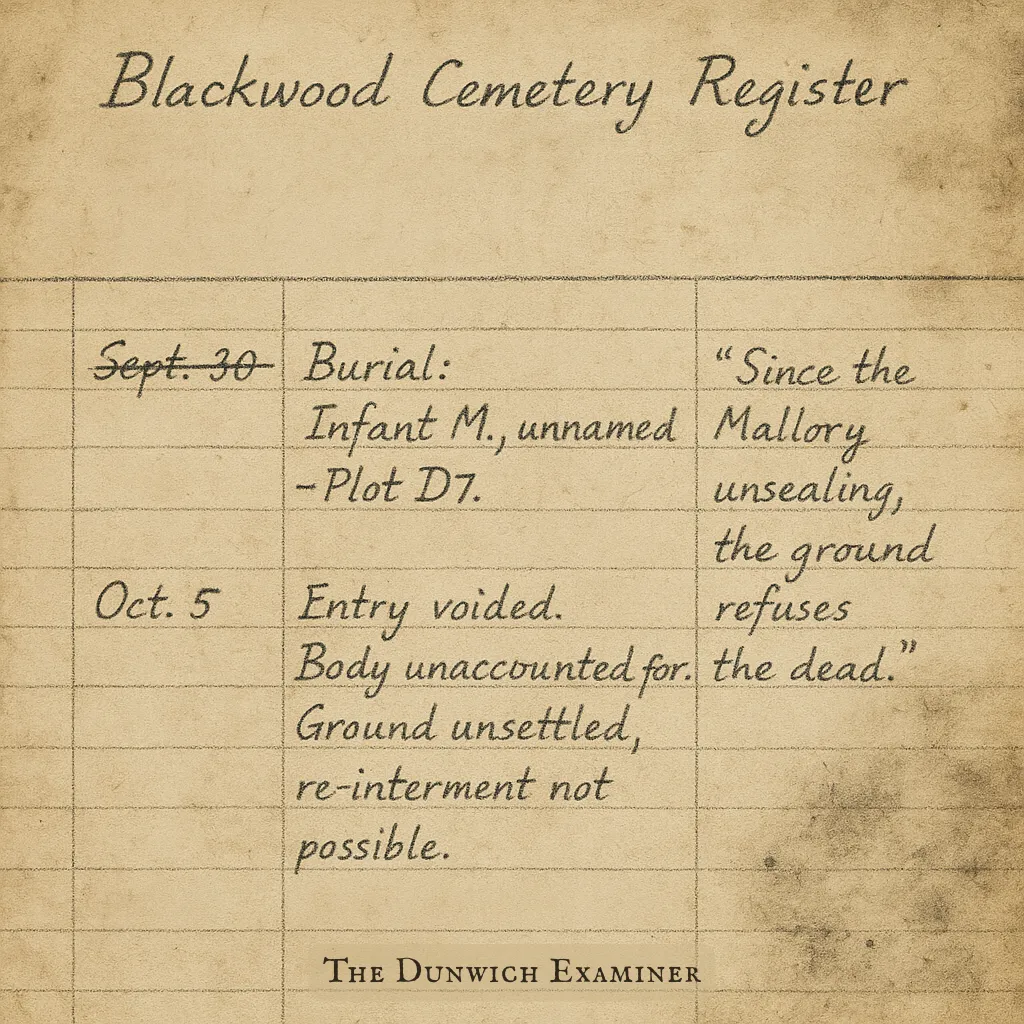
Blackwood Cemetery Register
Curator: Jeremiah Toll
- Sept. 30 – Burial: H. Calder, age 41 – Plot C12
- Oct. 5 – Entry voided. Body unaccounted for. Ground unsettled, re-interment not possible
[Note in margin: “Since the Mallory unsealing, the ground refuses the dead.”]
Crowe’s Personal Archive
Journal Entry: The Spiral Sigil
Nathaniel Crowe's personal reflections upon discovering a recurring spiral symbol within the Mallory estate.
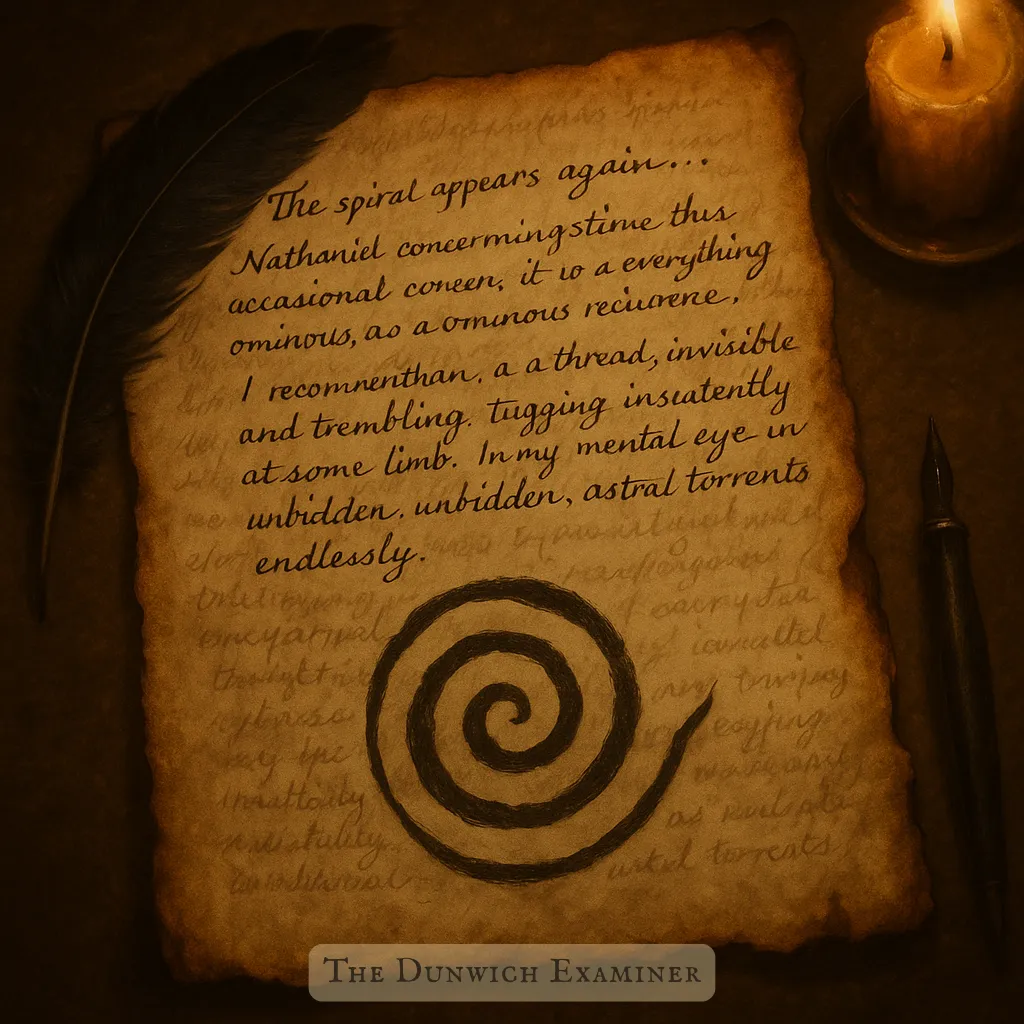
The spiral appears again, etched into the underside of a floorboard in the study. Its presence is unsettling, not due to its form, but the sensation it evokes—a pulling at the edges of consciousness. When I close my eyes, the spiral turns, drawing me inward. It's as if the symbol is not merely a mark, but a doorway. I must proceed with caution; the house watches.
Sketch: Glyph Rubbings from the Mallory Subcellar
Drawn directly into Crowe’s field journal, these rubbings depict markings discovered on the subcellar walls. He notes the impossibility of capturing their shifting design.
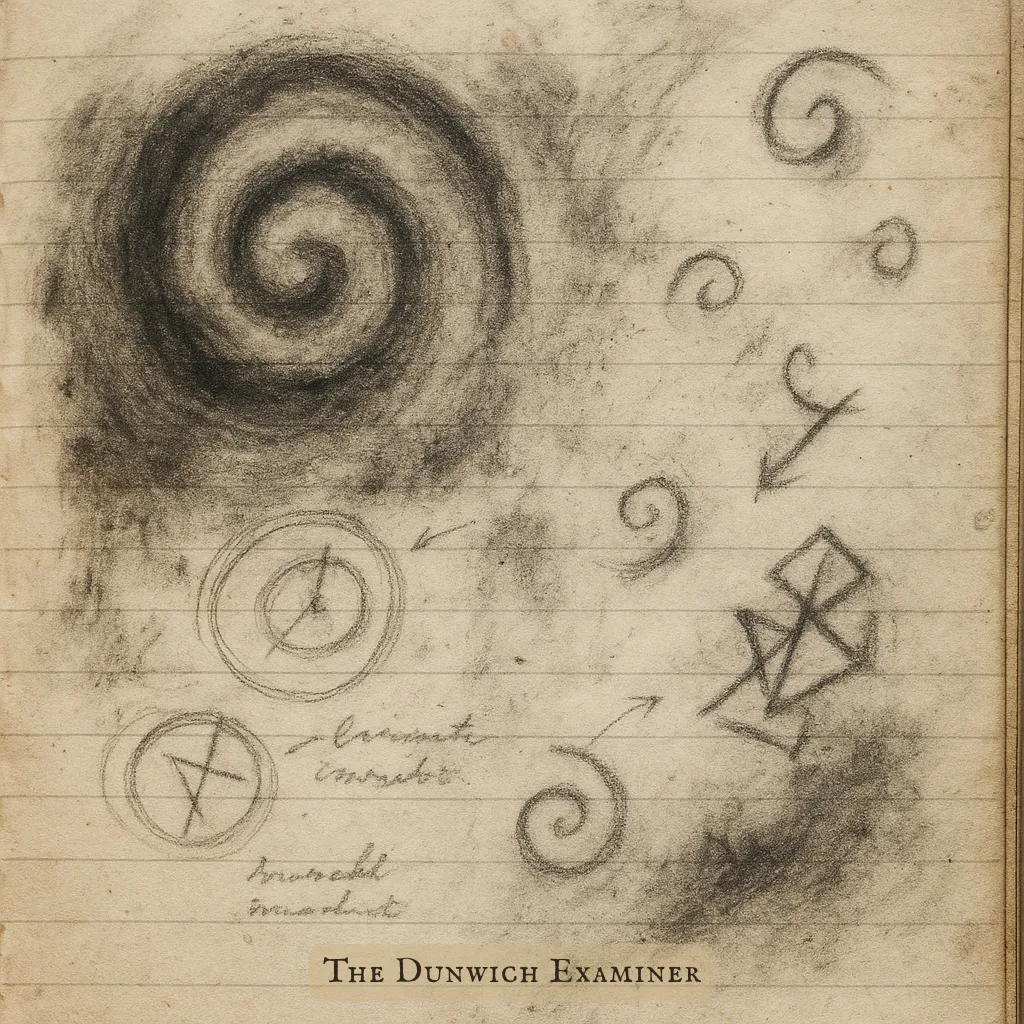
Journal Entry – October 4
The walls are inscribed with symbols not wholly fixed. My charcoal rubbings resist capture; lines fade where my hand was certain. One spiral opened upon itself as I drew, widening like an eye.
These glyphs are not merely marks but movements held in abeyance, waiting to resume. I fear the act of recording them may summon their completion.
Apocryphal Records
Transcription: Whispered Recitations from the Cellar
An attempt to transcribe the unintelligible whispers heard emanating from the depths of the Mallory cellar.
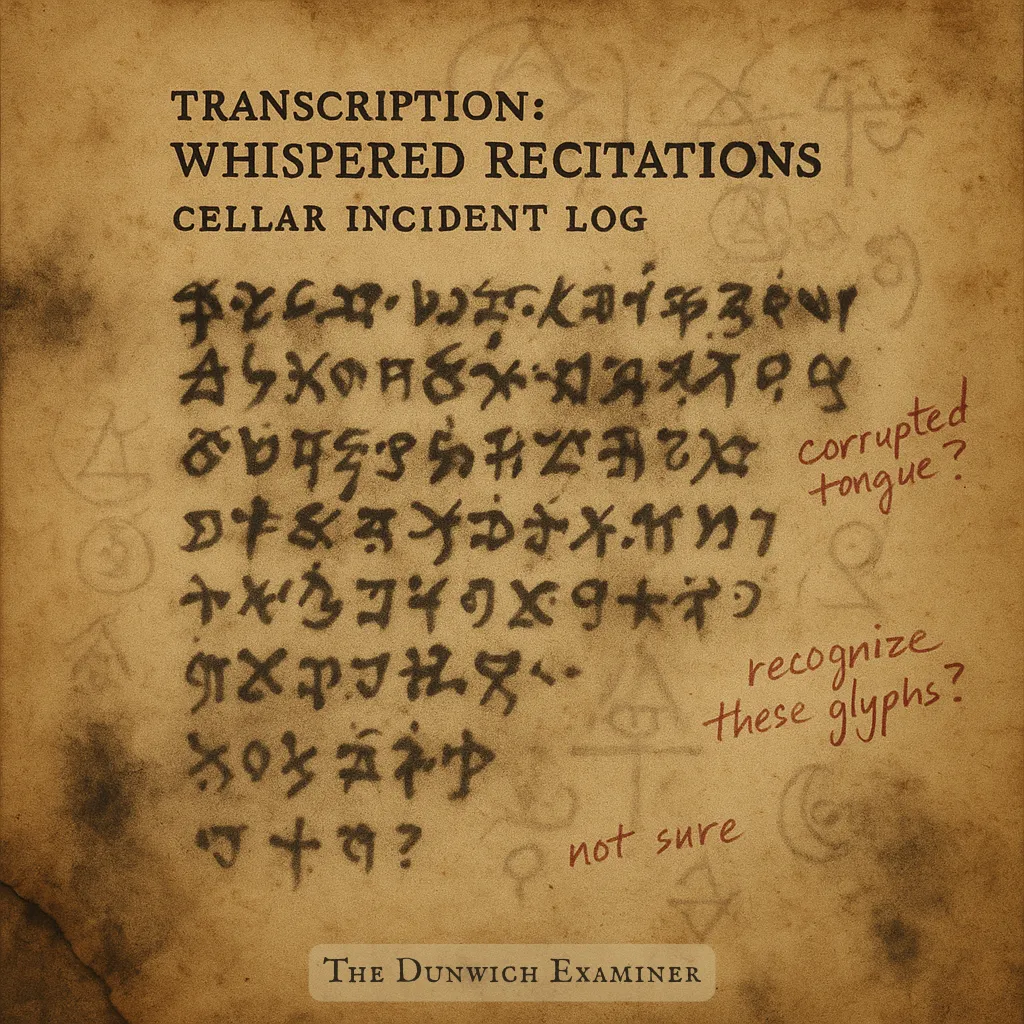
Transcriber: Unnamed
[Begin Transcript]
"...s̷e̷e̷k̷ ̷t̷h̷e̷ ̷v̷e̷i̷l̷ ̷b̷e̷n̷e̷a̷t̷h̷ ̷t̷h̷e̷ ̷s̷t̷o̷n̷e̷...
...t̷h̷e̷ ̷e̷y̷e̷ ̷o̷p̷e̷n̷s̷ ̷w̷h̷e̷n̷ ̷t̷h̷e̷ ̷b̷l̷o̷o̷d̷ ̷s̷i̷n̷g̷s̷...
...r̷e̷m̷e̷m̷b̷e̷r̷ ̷t̷h̷e̷ ̷n̷a̷m̷e̷ ̷t̷h̷a̷t̷ ̷w̷a̷s̷ ̷n̷e̷v̷e̷r̷ ̷s̷p̷o̷k̷e̷n̷..."
[End Transcript]
Note: The above phrases were captured during a two-minute window when the whispers intensified. The language appears to be a corrupted form of an ancient dialect, possibly pre-Sumerian. Further analysis required.
The Abyssal – Unpublished Appendix
A banned entry from a forbidden gazetteer, detailing a site so ruinous to the mind that no scholar has ever returned whole. The name is unrecorded—not by accident, but design.
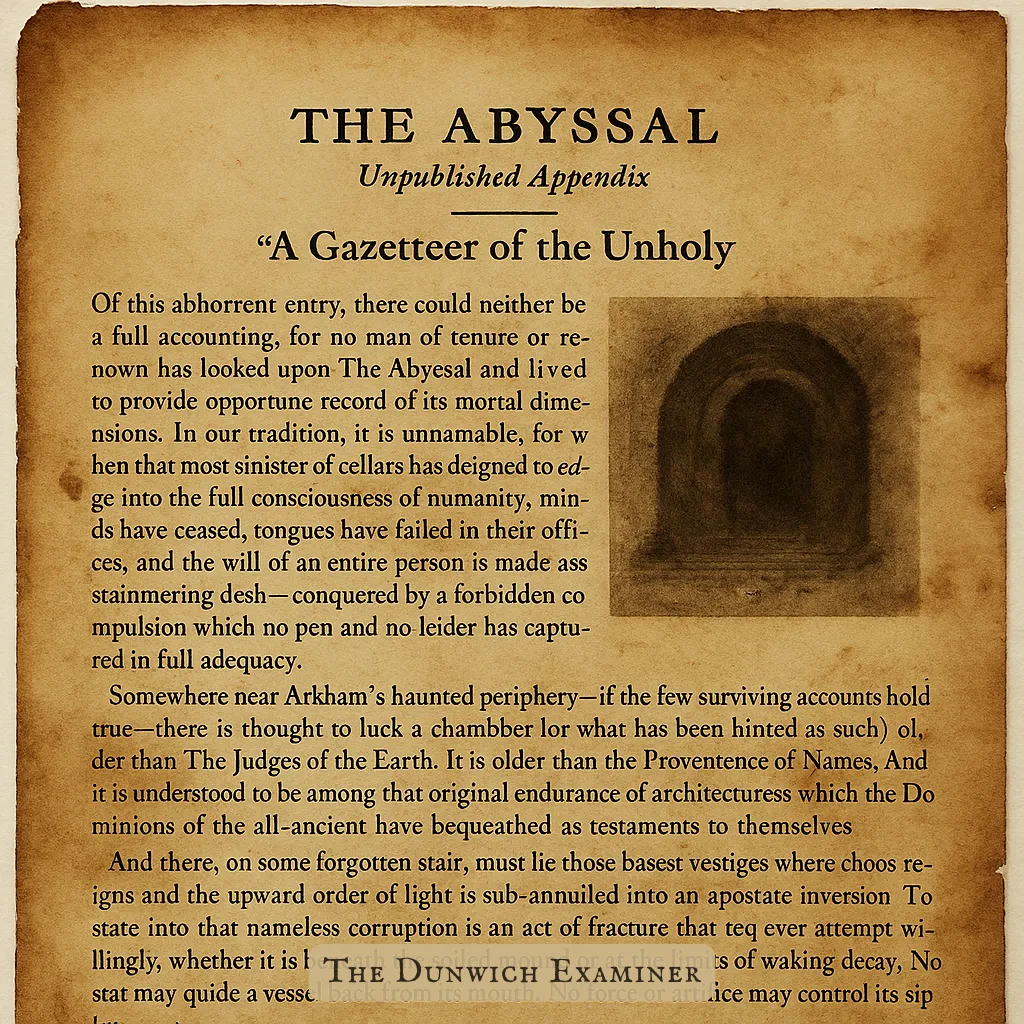
A Gazetteer of the Unholy
Of this abhorrent entry, there could neither be a full accounting, for no man of tenure or renown has looked upon The Abyssal and lived to provide opportune record of its mortal dimensions. In our tradition, it is unnamable, for when that most sinister of cellars has deigned to edge into the full consciousness of humanity, minds have ceased, tongues have failed in their offices, and the will of an entire person is made as stammering d̴e̴s̴h̴—conquered by a forbidden compulsion which no pen and no leiderman has captured in full adequacy.
Somewhere near Arkham’s haunted periphery—if the few surviving accounts hold true—there is thought to be a chamber for what has been hinted at as such only by The Judges of the Earth. It is older than the Provenance of Names. And it is understood to be among that original endurance of architectures which the Dominions of the all-ancient have bequeathed as testaments to themselves.
And there, on some forgotten stair, must lie those basest vestiges where chaos reigns and the upward order of light is sub-annulled into an apostate inversion. To state into that nameless corruption is an act of fracture that tears everlastingly, whether it is beneath the soiled mound or at the limits of waking decay. No stat may guide a vessel back from its mouth. No force or artifice may control its sight.
Maps and Diagrams
Architectural Sketch: Subterranean Layout of Mallory Estate
A recovered sketch detailing the previously undocumented underground structures beneath the Mallory estate.
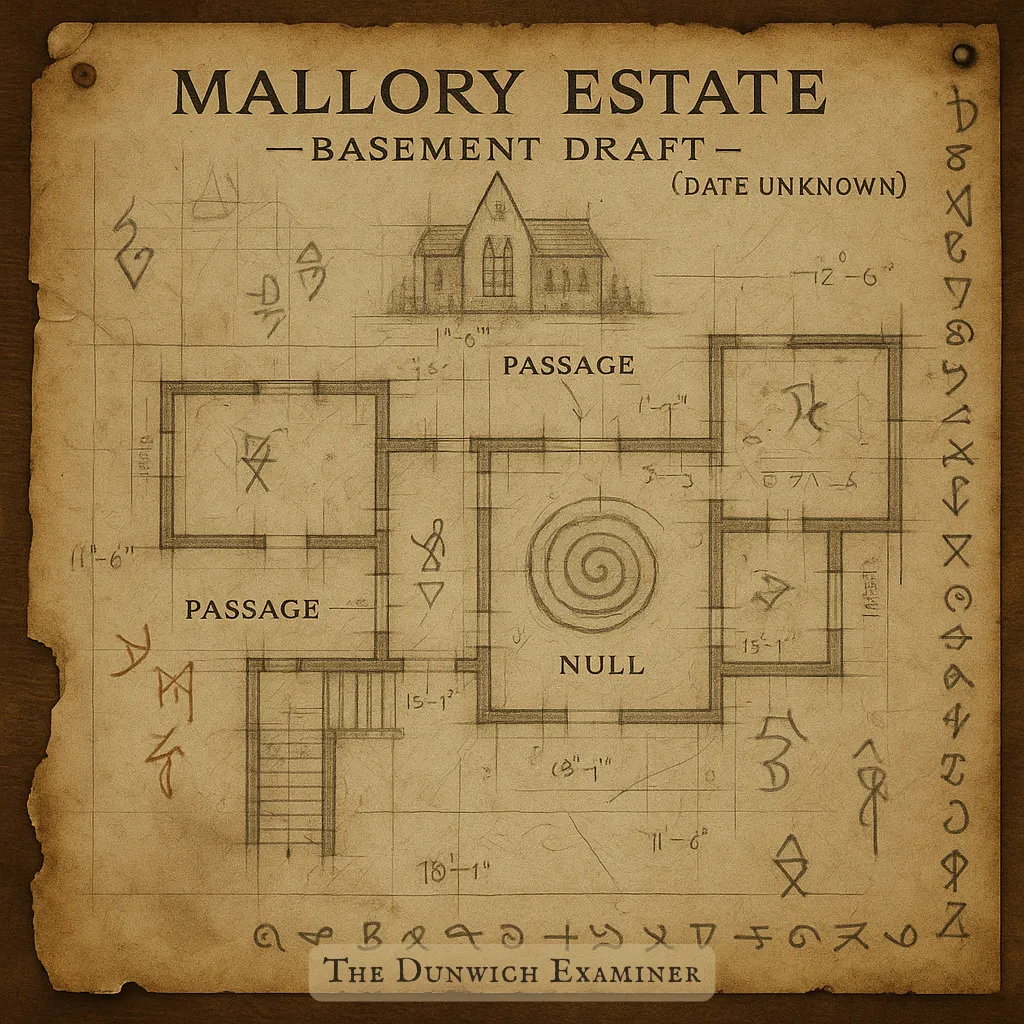
Source: Found among the personal effects of the late Jonathan Mallory
The sketch reveals a series of concentric chambers beneath the estate, each labeled with arcane symbols rather than conventional room names. At the center lies a chamber marked with a symbol resembling an eye within a spiral. Notably, a narrow passage extends beyond the central chamber, leading to an area simply labeled "Null." The purpose and origin of these structures remain a mystery.
_
